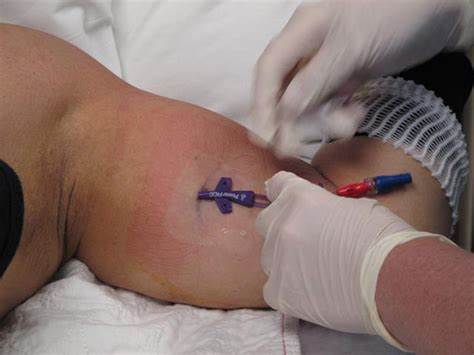The Mirror's Health , Lifestyle and Fashion

Treatment for leukemia
Sometimes a combination of these treatments are used. The choice of treatment depends mainly on:
Advertisement
• The type of leukemia (acute or chronic)
• Age of the patient
• Stage of the disease (whether leukemia cells have spread to other areas or not)
• Features of the leukemic cells.
Treatment of acute leukemia should be started urgently with the goal to destroy leukemic cells in the body as much as possible. With treatment, the signs and symptoms of leukemia will go away as much as possible, a phase called remission.
After people go into remission, more therapy is given to prevent the cancer from coming back, a phase called relapse. This type of therapy is called consolidation therapy or maintenance therapy. It is worth emphasising that many people with acute leukemia can be cured if treatment is sought early.
Chronic leukemia without symptoms may not need treatment right away. People may receive maintenance therapy to help keep the cancer in remission, but chronic leukemia can seldom be cured with chemotherapy.
However, stem cell transplantation offers some people with chronic leukemia the chance for a complete cure. This underscores why in many developed countries, the cord blood is stored for future reference.
People with chronic lymphocytic leukemia who do not have symptoms may be able to put off having cancer treatment. By delaying treatment, they can avoid the side effects of treatment until they have symptoms.
Regular check-ups must be conducted during this phase. Although watchful waiting avoids or delays the side effects of cancer treatment, it may reduce the chance to control the leukemia before it worsens.
Chemotherapy
Many people with leukemia are treated with chemotherapy. Chemotherapy is usually given in cycles and it involves the use of drugs to destroy leukemia cells.
Depending on the type of leukemia, a single drug or a combination of different drugs are used. The drug may be taken by mouth, through the vein or into the cerebrospinal fluid directly. Sometimes a special catheter called an Ommaya reservoir is placed under the scalp and the drug is injected through this catheter. This method avoids the pain of injections into the spinal fluid.
Injecting drugs directly into cerebrospinal fluid is necessitated by the fact that many drugs given through the vein or taken by mouth can't pass through the tightly packed blood vessel walls found in the brain and spinal cord.
This barrier called the blood-brain barrier needs to be traversed by most medications to concentrate in the brain. Injecting it directly into the cerebrospinal fluid ensures adequate concentration in the brain.
The side effects depend mainly on which drugs are given and how much. Chemotherapy kills fast-growing leukemia cells, but the drug can also harm normal cells that divide rapidly. This includes blood cells, hairs, cells that line the digestive tract and sperm or egg cells. Thus, chemotherapy drugs cause anaemia and increase susceptibility to infections. It also causes alopecia (hair loss), diarrhoea and vomiting and infertility depending on the cells involved.
Targeted Therapy
People with specific types of leukemia such as chronic myeloid leukemia and some with acute lymphoblastic leukemia may receive drugs called targeted therapy.
Certain drugs called target drugs are used to block the growth of leukemia cells. For example, a targeted therapy may block the action of an abnormal protein fuelling the growth of leukemia cells.
Biological therapy
Some people with leukemia receive drugs called biological therapy. Biological therapy for leukemia is treatment that improves the body's natural defenses against the disease.
One type of biological therapy is a substance called a monoclonal antibody. It is given by infusion through the vein and binds to the leukemic cells.
One kind of monoclonal antibody carries a toxin that kills the leukemia cells. Another kind helps the immune system to destroy the leukemic cells.
Radiation therapy
Radiation therapy (also called radiotherapy) uses high-energy rays to kill leukemic cells. Some people receive radiation from a large machine that is aimed at specific organs such as the spleen, brain, or other parts of the body where leukemic cells have collected.
This type of therapy takes place five days a week for several weeks. Others may receive radiation that is directed to the whole body. The radiation treatments are given once or twice a day for a few days, usually before a stem cell transplant.
Stem cell transplant
A stem cell transplant allows for treatment with high doses of drugs, radiation, or both. The high doses destroy both leukemia cells and normal blood cells in the bone marrow.
After the high-dose chemotherapy, radiation therapy, or both, healthy stem cells are infused through a large vein. New blood cells develop from the transplanted stem cells. The new blood cells replace the ones that were destroyed by treatment. Stem cells may come from self (autologous stem cell) or from
someone who donates their stem cells (allogenic).
Stem cells come from a few sources. The stem cells usually come from the blood (peripheral stem cell transplant) or they can come from the bone marrow (bone marrow transplant). Another source of stem cells is umbilical cord blood.
Cord blood is taken from a newborn baby and stored in a freezer. When a person gets cord blood, it's called an umbilical cord blood transplant.
People undergoing treatment for leukemia will need nutritional support, treatment for frequent infections, frequent blood transfusions or blood building medications as well as social support. There is a huge financial implication and so financial and psychological support are vital. And that is why I once again want to applaud the National Health Insurance Authority for extending its cover to include childhood cancer which is curable in most instances.
[email protected]
A member of Paediatric Society of Ghana




